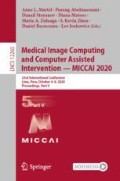Abstract
Anterior chamber angle (ACA) classification is a key step in the diagnosis of angle-closure glaucoma in Anterior Segment Optical Coherence Tomography (AS-OCT). Existing automated analysis methods focus on a binary classification system (i.e., open angle or angle-closure) in a 2D AS-OCT slice. However, clinical diagnosis requires a more discriminating ACA three-class system (i.e., open, appositional, or synechial angles) for the benefit of clinicians who seek better to understand the progression of the spectrum of angle-closure glaucoma types. To address this, we propose a novel sequence multi-scale aggregation deep network (SMA-Net) for open-appositional-synechial ACA classification based on an AS-OCT sequence. In our method, a Multi-Scale Discriminative Aggregation (MSDA) block is utilized to learn the multi-scale representations at slice level, while a ConvLSTM is introduced to study the temporal dynamics of these representations at sequence level. Finally, a multi-level loss function is used to combine the slice-based and sequence-based losses. The proposed method is evaluated across two AS-OCT datasets. The experimental results show that the proposed method outperforms existing state-of-the-art methods in applicability, effectiveness, and accuracy. We believe this work to be the first attempt to classify ACAs into open, appositional, or synechial types grading using AS-OCT sequences.
Access this chapter
Tax calculation will be finalised at checkout
Purchases are for personal use only
References
Tham, Y.C., Li, X., Wong, T.Y., Quigley, H.A., Aung, T., Cheng, C.Y.: Global prevalence of glaucoma and projections of glaucoma burden through 2040: a systematic review and meta-analysis. Ophthalmology 121(11), 2081–2090 (2014)
Fu, H., et al.: A deep learning system for automated angle-closure detection in anterior segment optical coherence tomography images. Am. J. Ophthalmol. 203, 37–45 (2019)
Foster, P.J., Buhrmann, R., Quigley, H.A., Johnson, G.J.: The definition and classification of glaucoma in prevalence surveys. Br. J. Ophthalmol. 86(2), 238–242 (2002)
Fu, H., et al.: Angle-closure detection in anterior segment OCT based on multilevel deep network. IEEE Trans. Cybern. 50(7), 3358–3366 (2019)
Shang, Q., et al.: Automated IRIS segmentation from anterior segment OCT images with occludable angles via local phase tensor. In: IEEE EMBC, pp. 4745–4749 (2019)
Xu, Y., et al.: Anterior chamber angle classification using multiscale histograms of oriented gradients for glaucoma subtype identification. In: IEEE EMBC, pp. 3167–3170 (2012)
Xu, Y., et al.: Automated anterior chamber angle localization and glaucoma type classification in OCT images. In: IEEE EMBC, pp. 7380–7383 (2013)
Fu, H., et al.: Segmentation and quantification for angle-closure glaucoma assessment in anterior segment OCT. IEEE Trans. Med. Imaging 36(9), 1930–1938 (2017)
Zhao, Y., et al.: Automatic 2-D/3-D vessel enhancement in multiple modality images using a weighted symmetry filter. IEEE Trans. Med. Imaging 37(2), 438–450 (2017)
Zhao, Y., et al.: Intensity and compactness enabled saliency estimation for leakage detection in diabetic and malarial retinopathy. IEEE Trans. Med. Imaging 36(1), 51–63 (2016)
Zhao, Y., et al.: Retinal artery and vein classification via dominant sets clustering-based vascular topology estimation. In: Frangi, A.F., Schnabel, J.A., Davatzikos, C., Alberola-López, C., Fichtinger, G. (eds.) MICCAI 2018. LNCS, vol. 11071, pp. 56–64. Springer, Cham (2018). https://doi.org/10.1007/978-3-030-00934-2_7
Xu, B.Y., Chiang, M., Chaudhary, S., Kulkarni, S., Pardeshi, A.A., Varma, R.: Deep learning classifiers for automated detection of gonioscopic angle closure based on anterior segment OCT images. Am. J. Ophthalmol. 208, 273–280 (2019)
Hao, H., et al.: Anterior chamber angles classification in anterior segment OCT images via multi-scale regions convolutional neural networks. In: IEEE EMBC, pp. 849–852 (2019)
Chollet, F.: Xception: deep learning with depthwise separable convolutions. In: IEEE CVPR, pp. 1251–1258 (2017)
Yu, F., Wang, D., Shelhamer, E., Darrell, T.: Deep layer aggregation. In: IEEE CVPR, pp. 2403–2412 (2018)
He, K., Zhang, X., Ren, S., Sun, J.: Deep residual learning for image recognition. In: IEEE CVPR, pp. 770–778 (2016)
Tran, D., Bourdev, L., Fergus, R., Torresani, L., Paluri, M.: Learning spatiotemporal features with 3D convolutional networks. In: IEEE CVPR, pp. 4489–4497 (2015)
Carreira, J., Zisserman, A.: Quo vadis, action recognition? A new model and the kinetics dataset. In: IEEE CVPR, pp. 6299–6308 (2017)
Xie, S., Sun, C., Huang, J., Tu, Z., Murphy, K.: Rethinking spatiotemporal feature learning: speed-accuracy trade-offs in video classification. In: Ferrari, V., Hebert, M., Sminchisescu, C., Weiss, Y. (eds.) ECCV 2018. LNCS, vol. 11219, pp. 318–335. Springer, Cham (2018). https://doi.org/10.1007/978-3-030-01267-0_19
Annunziata, R., Kheirkhah, A., Aggarwal, S., Hamrah, P., Trucco, E.: A fully automated tortuosity quantification system with application to corneal nerve fibres in confocal microscopy images. Med. Image Anal. 32, 216–232 (2016)
Zhao, Y., et al.: Automated tortuosity analysis of nerve fibers in corneal confocal microscopy. IEEE Trans. Med. Imaging. 39(9), 2725–2738 (2020)
Xia, X., Xu, C., Nan, B.: Inception-v3 for flower classification. In: IEEE ICIVC, pp. 783–787 (2017)
Fu, H., et al.: Multi-context deep network for angle-closure glaucoma screening in anterior segment OCT. In: Frangi, A.F., Schnabel, J.A., Davatzikos, C., Alberola-López, C., Fichtinger, G. (eds.) MICCAI 2018. LNCS, vol. 11071, pp. 356–363. Springer, Cham (2018). https://doi.org/10.1007/978-3-030-00934-2_40
Fu, H., Li, F., Sun, X., et al.: AGE challenge: angle closure glaucoma evaluation in anterior segment optical coherence tomography. arXiv (2020)
Acknowledgements
This work was supported by Zhejiang Provincial Natural Science Foundation of China (LZ19F010001, LQ19H180001), Ningbo “2025 S&T Megaprojects” (2019B10033, 2019B10061).
Author information
Authors and Affiliations
Corresponding authors
Editor information
Editors and Affiliations
Rights and permissions
Copyright information
© 2020 Springer Nature Switzerland AG
About this paper
Cite this paper
Hao, H. et al. (2020). Open-Appositional-Synechial Anterior Chamber Angle Classification in AS-OCT Sequences. In: Martel, A.L., et al. Medical Image Computing and Computer Assisted Intervention – MICCAI 2020. MICCAI 2020. Lecture Notes in Computer Science(), vol 12265. Springer, Cham. https://doi.org/10.1007/978-3-030-59722-1_69
Download citation
DOI: https://doi.org/10.1007/978-3-030-59722-1_69
Published:
Publisher Name: Springer, Cham
Print ISBN: 978-3-030-59721-4
Online ISBN: 978-3-030-59722-1
eBook Packages: Computer ScienceComputer Science (R0)


